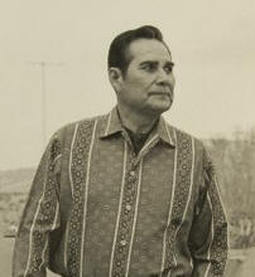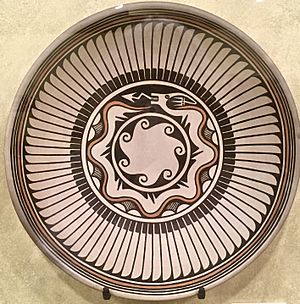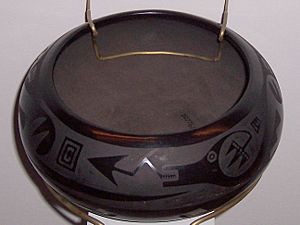Popovi Da facts for kids
Quick facts for kids
Popovi Da
|
|
|---|---|
 |
|
| Born |
Antonio Martinez
May 10, 1923 San Ildefonso Pueblo
|
| Died | October 17, 1971 (aged 48) Santa Fe, New Mexico
|
| Nationality | Pueblo of San Ildefonso, American |
| Style | black-on-black ware and polychrome pottery, painting |
| Spouse(s) | Anita Da |
| Elected | Governor of San Ildefonso Pueblo |
Popovi Da (1923–1971) was a talented San Ildefonso Pueblo Native American potter. He was also known by his birth name, Tony Martinez. Popovi Da worked closely with his famous mother, Maria Martínez, who was also a potter. He also created his own unique art. He was chosen to be the Governor of San Ildefonso Pueblo six times, starting in 1952.
His Early Life
Popovi Da was born Antonio Martinez in San Ildefonso Pueblo, in Northern New Mexico. His parents, Maria Martínez and Julían Martínez, were both well-known potters.
During World War II, Popovi Da served in the Army. Later, in 1944–45, he worked as a machinist for the Manhattan Project in Los Alamos. This project was a secret effort to build the first atomic bomb.
After the war, he officially changed his name to his Pueblo name, Popovi Da. This name means "Red Fox" in the Tewa language. Popovi Da and his wife, Anita Da, had four children: Tony Da, Bernard Kahrahrah, Joyce Da, and Janice Da.
His Art Career
Popovi Da began working with his mother, Maria Martinez, in the 1940s. He helped her by gathering clay and making the special paints she used for her pottery. He and his wife, Anita Da, who was from Santa Clara Pueblo, opened the Popovi Da Studio of Indian Art at their pueblo.
Popovi Da went to the Santa Fe Indian School and graduated in 1939. He became very skilled at painting the designs on his mother's pottery. They worked together for 20 years. Together, they helped bring back and improve the traditional pottery style of San Ildefonso.
Popovi Da was known for being very creative and trying new things in his art. He made pots with a perfectly smooth, shiny surface that looked like "gunmetal." At that time, it was mostly women who made pottery in his culture. Men usually helped them. After his father passed away in 1956, Popovi Da started helping his mother even more. By 1962, he began creating his own new pottery styles. From 1956 onwards, the pots he made with his mother were signed "Maria/Popovi."
In the 1960s, he started adding pieces of turquoise into his pots. He also used a technique called sgraffito, where he would scratch or carve designs onto the surface. He even found a way to create beautiful color fades, from black to sienna (a reddish-brown), by carefully covering parts of his pots during the firing process. In the 1970s, he began working with his own son, Tony Da (1940–2008), who also became a famous potter.
Besides his art, Popovi Da was also a leader in his community. In 1952, he was elected Governor of San Ildefonso Pueblo and served six terms. He also led the All Pueblo Council of Governors, which is a group that represents many Pueblo communities.
His important papers, reviews, and exhibition catalogs are kept at the Smithsonian Institution, which is a famous museum and research center.
Where His Art Is Displayed
Popovi Da's artwork can be found in many important museums. These include the Museum of Modern Art, the Museum of the Art Institute of Chicago, the Seattle Art Museum, the National Museum of the American Indian, and the McNay Art Museum.



